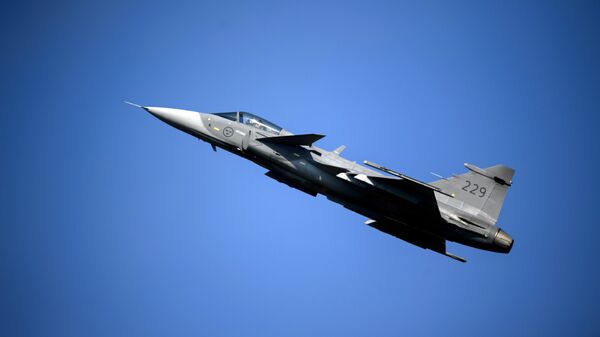New Delhi (Sputnik) — India might do away with the engine criteria for the planned purchase of over a hundred fighter jets for its air force, widening the scope of competition among foreign vendors supplying both single-engine as well as double-engine fighter crafts.
Highly placed sources told Sputnik that India's defense ministry wants an open fighter jet contest like the earlier deal for medium multi-role combat aircraft wherein the main criteria would be the technical capabilities of the jet not the number of engines. The new development has come as a rude awakening to American Lockheed Martin and Swedish Saab who were keenly anticipating a tender specifically for single engine fighter jets making the F-16 and Gripen the front-runners in the $10 billion deal.
"The government has not started any formal process for the proposed jet deal…not even finalized the request for information. The Indian Air Force always wanted a more capable fighter jet and if the government does away with the number of engine criteria then definitely twin-engine manufacturers will have the upper hand," Amit Cowshish, former financial advisor to the Indian defense ministry told Sputnik.
The 2007 medium multi-role combat aircraft contest, also based on capability and not the number of engines, had six fighter aircraft: Boeing F/A-18E/F Super Hornet, Dassault Rafale, Eurofighter Typhoon, Lockheed Martin F-16 Fighting Falcon, Mikoyan MiG-35, and Saab JAS 39 Gripen. Four years later in 2011, after detailed evaluation, the contest reduced the bidders to two fighters- Eurofighter Typhoon and Dassault Rafale as others failed to meet the criteria.
"The Gripen and F-16 were not able to pass the technical criteria set out by the Indian Air Force in the 2007 MMRCA contest, this time they have likely to come up with better preparation to beat the technical parameters," Cowshish added.
Nevertheless, these developments have definitely dealt a blow to single-engine jet manufacturers that have already linked up with Indian partners and have even started deliberations with suppliers. Swedish defense and security firm Saab has linked up with India's Adani Group — a new entrant in the field of defense aerospace, while in June of this year, Lockheed Martin from the US had intended to join hands with India's Tata Advanced System to produce the F-16 Block 70 in India.
"The open competition without mentioning the number of engines may be the end of the road for single-engine jet makers as they are unlikely to compete with twin-engine jets," Cowshish said.
Earlier in October, Air Chief Marshal BS Dhanoa had categorically stated that the emphasis on single-engine fighter jets was a cost-cutting attempt whereas the Indian Air Force actually desired twin-engine jets.
"Right now, we are concentrating on the single-engine so as to make up the numbers with lower cost. There is a requirement for twin-engine fighters down the road, but engines are "30% of the cost" of a twin, versus 10% of a single," Dhanoa had said.






